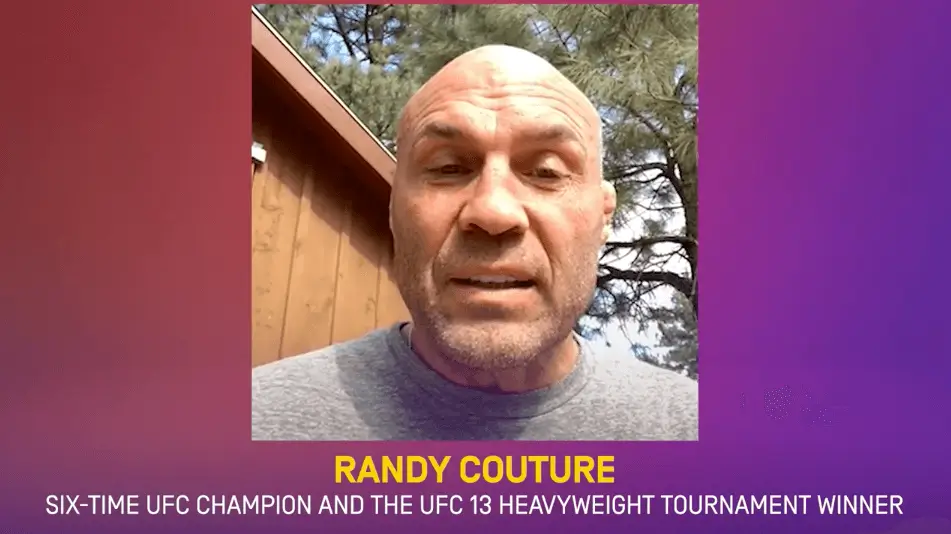The art of call scripting: three winning sales script examples
Ah. Sales scripts — the elusive and oft-discussed topic on every sales team’s agenda (or should be).
Sure, some Sales teams seem to be more script-driven than others, but have you ever considered exactly what makes up a sales script? Or how you could use a sales script to boost your conversion rates?
As always here at Gong, our recommendations are based on data … not assumptions. You will likely look at a few tips below and say (out loud?), “Wait. Really?” The answer to that question is, “Well, yeah, if you believe in data.”
This article will dive into everything sales script-related, breaking down examples into 3 stages of the sales cycle — cold call, discovery, and demo. Along the way, we’ll share concrete examples that you can copy/paste/customize … as well as a free PDF to get you on your way to success.
But before we start, let’s answer the question: What is a sales script?
What is a sales script?
A sales script, sometimes referred to as a “call script,” is a detailed design or blueprint for how you would like a sales conversation to go, depending on which stage of the sales funnel (cold call, discovery, demo, etc.) you are in. The goal: increase your success rate in any sales situation.
For more on sales scripts, check out these 3 money-making scripts.
Cold call sales script example #1: Cold call opener
Ask any sales rep what they think about cold calling, and they will jump at the chance to tell you their thoughts and feelings.
Generally speaking, it’s either LOVE or HATE (mostly hate, if we are being honest) … and not much in between.
Cold calling can feel robotic and forced for those who are not fans. But if you are on the other end of the spectrum, cold calling can be the best part of your day.
A tremendous cold call — one that is more likely to lead to success (a booked follow-up meeting) — is where it all starts.
Here’s a successful cold calling example:
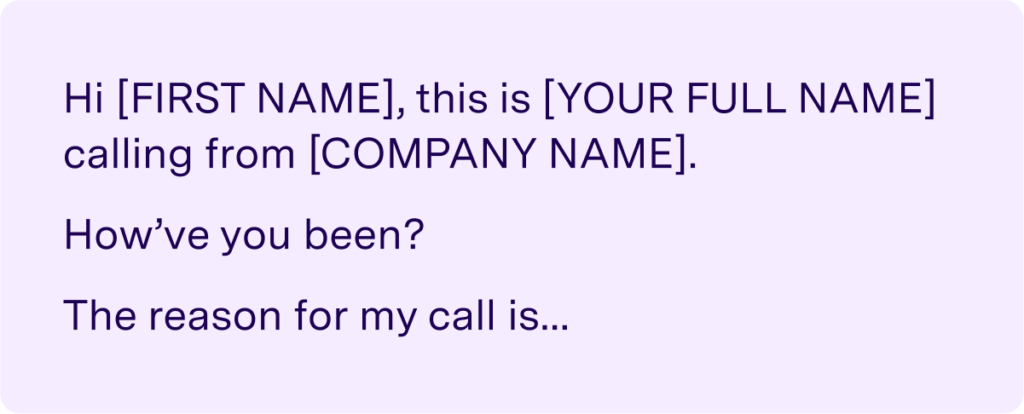
Always lead with their first name. As Dale Carnegie once said, “A person’s name is to that person, the sweetest, most important sound in any language.” The science backs up that claim.
Follow your “Hi [FIRST NAME]” with your FULL name. If you introduce yourself with your full name, you instantaneously command respect. Which sounds better?
A: “Hi, Jim, this is Jon.”
B: “Hi, Jim, this is Jonathan Costet.”
B!
Follow your full first name with your organization’s name. This tactic allows you to control the conversation. Instead of the person on the other end saying, “Who is this and who are you with?” you can move right into the next part.
“How’ve you been?” is a pattern interrupt — it breaks the “normal” cold call examples we “should” be using (quotes intentional).
Scrap the “Can I have a minute of your time?” type opening question for a “brain scrambler” open-ended question such as “How’ve you been?”
The data supports this tactic: Cold calls using the opening line “How’ve you been?” are 6.6X more successful in getting a meeting booked.
Finally,*, close with the reason for your call — to enjoy a 2.1X higher success rate in booking that first meeting. This approach works because humans need reasons. You’ve answered it before they can ask, “Why are you calling me?”
*It goes without saying that you need to let them answer your question before ending this opener!
Cold call sales script example #2: Targeted value prop
If you still have a live body on the other end of the call, it’s time to drive home your targeted (read: not generic) value proposition, aka TVP << I made that up.
Here is what it looks like:
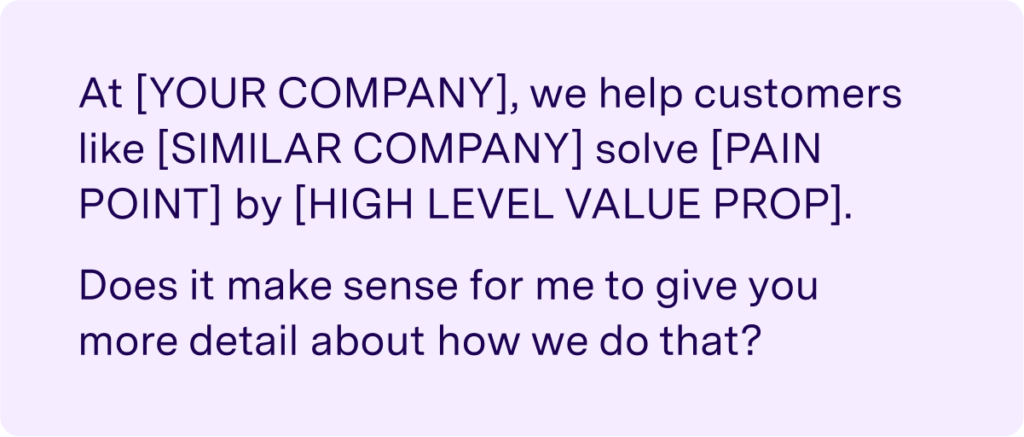
Targeted means everything in brackets ([ ]) is customized and personalized to this buyer. That‘s not to say you can’t have a few account personas (think: account based marketing or ABM) where you plug in specific sales scripts that match these accounts “similar company” and “pain point” and “high-level value prop.”
After subbing in [YOUR COMPANY] with, well, your company’s name, it’s time to find a customer that you can use as social proof. Of course, the customer must belong to the prospect’s “tribe” – similar industry, size, geography, and so on. This is critical: This tactic backfires if you plug in the wrong [SIMILAR COMPANY]. Gong data show win rates plummet by 47% in early-stage deals. Eeks.
Equally important, {PAIN POINT] and [HIGH LEVEL VALUE PROP] must be aligned with and recognizable with (a) the prospect you are speaking with and (b) relevant to that account’s industry.
Finally, close out this section with an interest CTA , a question such as “Does it make sense for me to give you more detail about how we do that?”
The Interest CTA is the highest performing call to action for cold emails — 2X better than other CTAs.
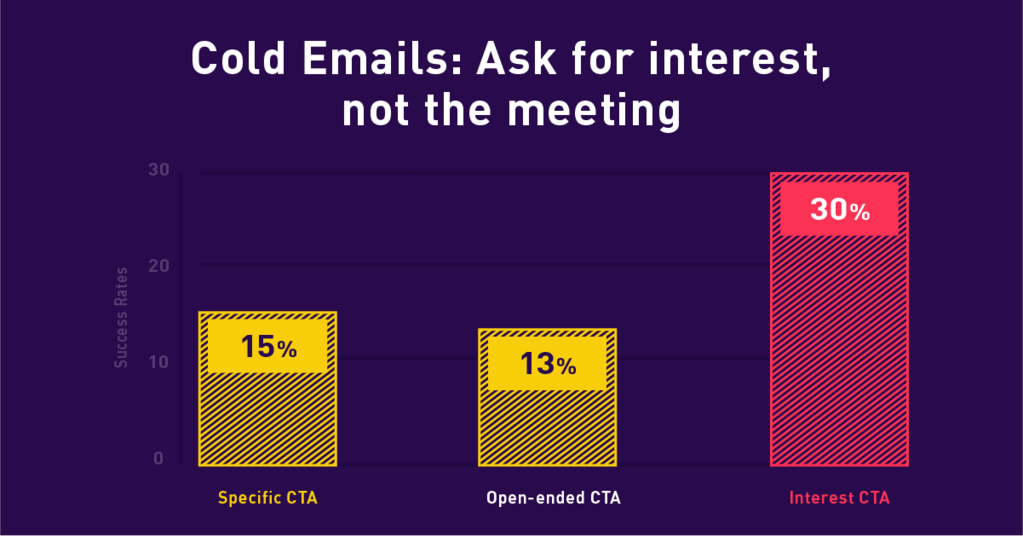
Why? You are selling the conversation, not the meeting.
You are NOT asking for time (finite) … just interest.
Once the prospect gives the go-ahead — Yeah. Sure. Yes. HECK YEAH! Let’s do this! — it’s time to go in for the close (booked meeting).
Cold call script example #3: Closing
You’ve made it to the end of the cold call sales script. You are rising for the dunk, at the goal line, about to hit that 3-2 pitch over the fence for the win, [INSERT ANOTHER SPORTS ANALOGY HERE].
The close: Getting the meeting booked.
Here’s what it looks sounds like:
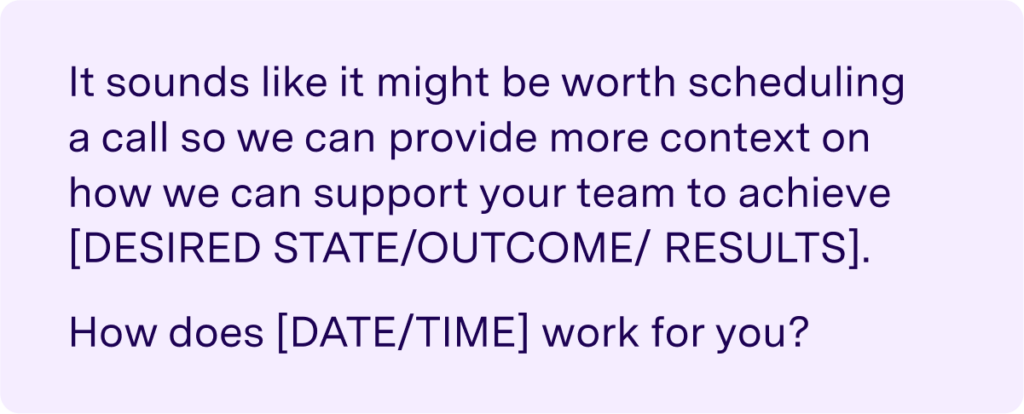
The first part, “It sounds like …” should be framed as an offer.
- To give you more details about how our product/service can solve your pain (like we did for similar companies), you need to agree to a meeting.
- You get the specifics about how we get you to your desired state/outcome/results.
- All you have to do is say yes.
Then the close (close) is actually getting a specific date and time for the follow-up meeting booked.
No need for the aforementioned “interest CTA,” as they’ve already said yet (#3 above). Interested established! It’s time for a direct approach — remove friction, make it easy for your buyer to move on to the next steps.
Wait. What if they say NO to #3? We’ve got a sales script for that too.
Discovery call script: Meet them where they stand
You’ve made it through the challenging (or easy?) part — the cold call.
Your buyer said YES! They’ve agreed to meet. They showed up for the meeting.
Now what?
It’s your turn to meet. Specifically, meet your buyer where they stand.
Huh?
Said another way, match your sales discovery questions to the buyer’s journey — the specific buyer you are speaking with, of course.
Refresher on the stages of the buyer’s journey:
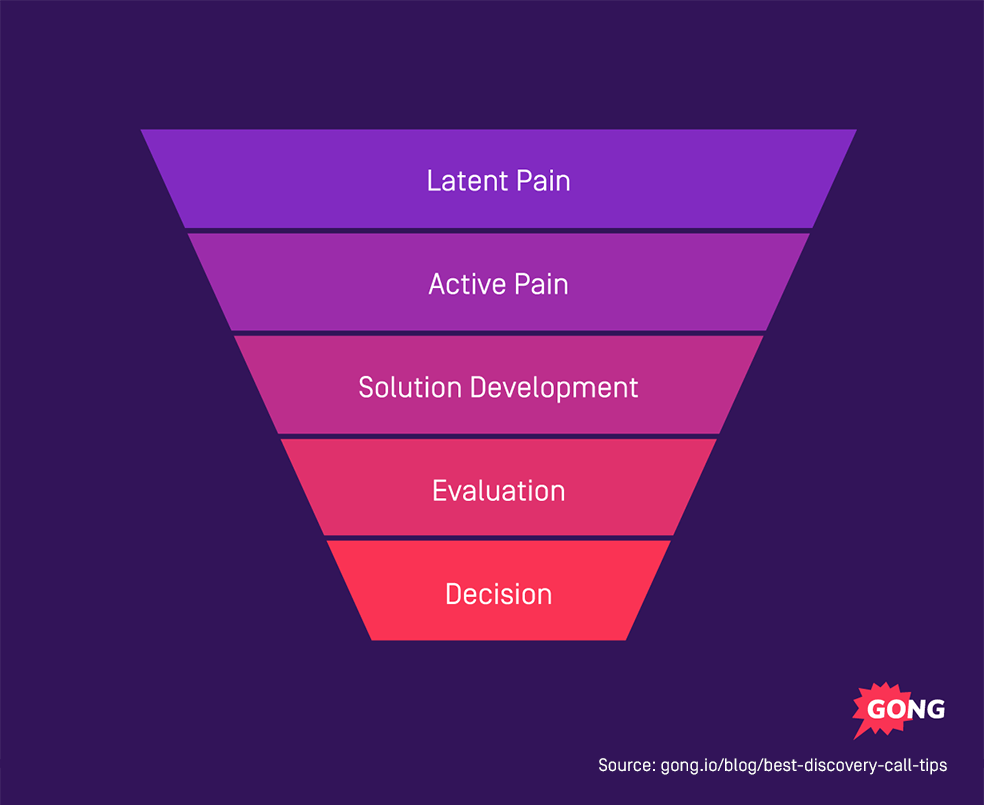
If you lead with sales discovery questions that uncover latent pain, yet your buyer is already
evaluating products, you are NOT meeting them where they are. So instead, start with a question like: “What do you hope to achieve by implementing a solution?” There is no weirdness around this question, as this is (hopefully) why your buyer is talking with you!
Let’s start at the top: Latent pain.
Discovery call sales script example #1: Latent pain
Latent pain is at the top of the buyer’s journey “funnel,” as depicted in the image above.
This is the stage where the buyer KNOWS (acknowledges, openly or in their head) they have a problem, but … well … they are not quite ready to do anything, not willing to make a change.
Their business problem is annoying, maybe even hindering them somehow, but not enough to (a) do the research or (b) invest time/resources/$$ into a product or service.
They are not actively searching for what you are promising.
Your goal in asking a latent pain question is to get the buyer to open up about a possible fit between what’s important to them and what you are selling.
“What do you hope to achieve by implementing a solution?” is a safe opener. There is no friction as it’s what they want to discuss.
This “what” question and other “why/what/where/how” questions are the answer to pull out the information you need during discovery.
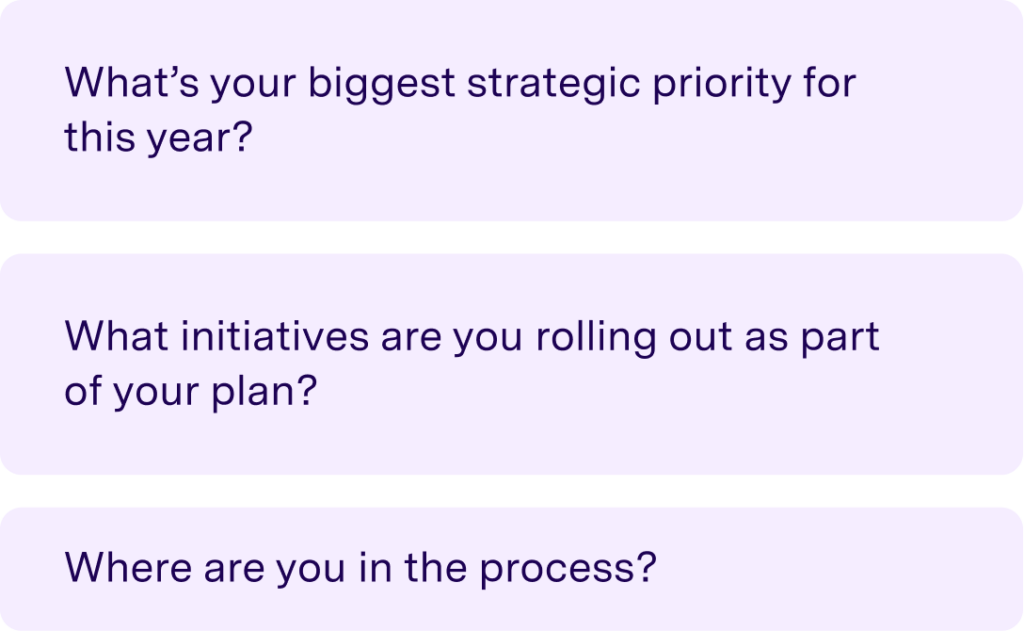
Discovery call script example #2: Active pain
Many buyers skip the latent pain stage and move directly into active pain. Think: Just about every inbound lead — especially demo requests, general sales inquiries, chatbot clicks on “connect me with a sales rep right now,” etc.
These are the leads we all want — warm or even hot.
The stager — active pain — is all about the diagnosis. You are a nurse or doctor, and the patient has just entered the eval room.
You are looking to ask questions that will:
- Evaluate the symptoms,
- Explore current fixes, and
- Determine urgency.
These are your key discovery call questions:
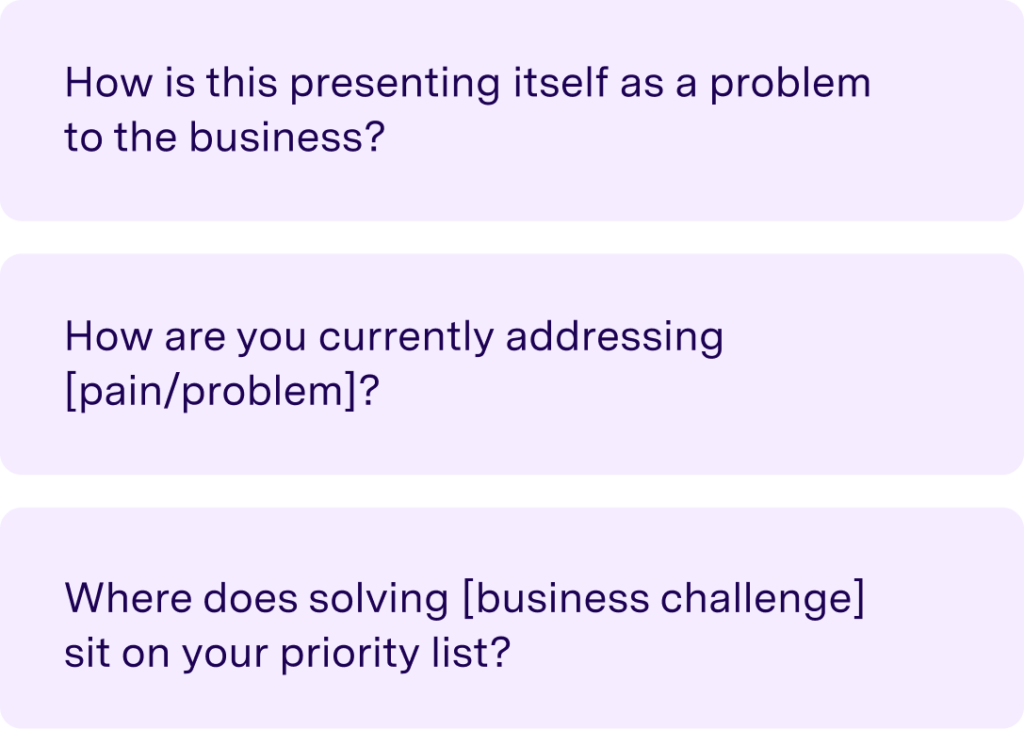
Buyers at this stage are well-aware something is not working or could be improved. They are actively seeking a solution that will “cure” that pain. You do not need to convince them of their pain as you do during the latent pain stage.
Any discrepancy here is more ammo you can use to move into impact questions.
Discovery call sales script example #3: Solution development
What happens if …
What is your boss looking for …
Your goal in this solution development stage is to, well, provide solutions! The key: the buyer needs to tell you “what would happen if … “ So your questions need to be those that will help the buyer discuss the potential (positive, we hope!) impact your offering will have on them and their job/business.
Questions you should consider asking during the solution development stage of the buyer’s journey include:
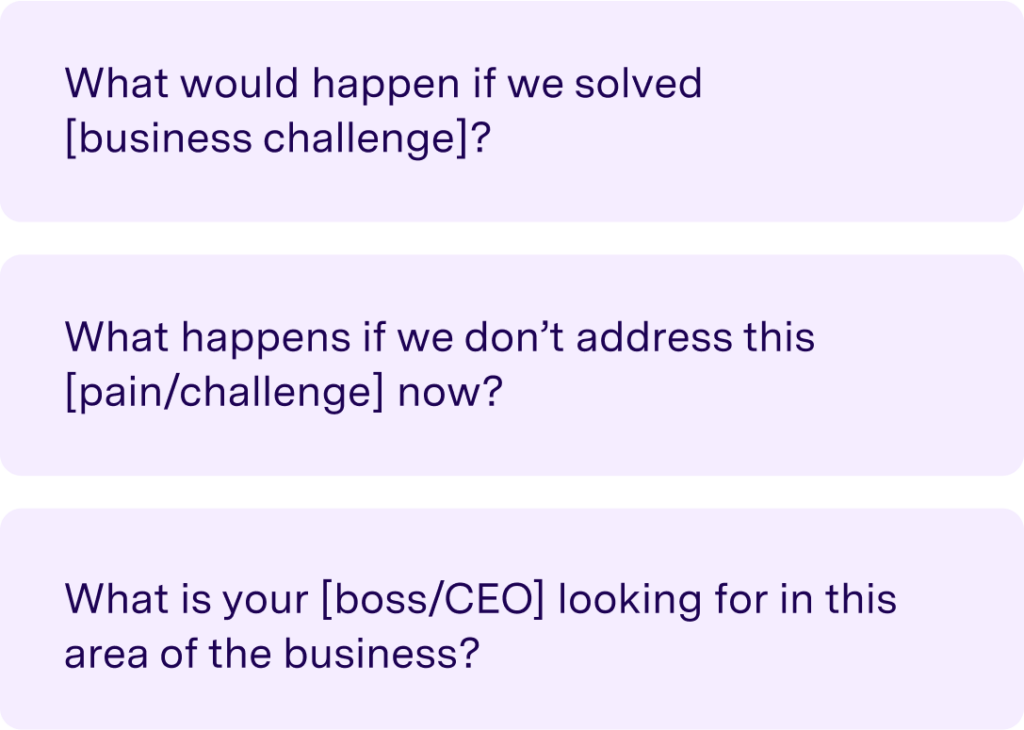
All of these questions help your buyer envision a world where your product or solution does NOT exist.
You are helping your buyer gather data to (a) make a decision or (b) convince their team/boss.
Discovery call sales script: Aim for 11-14 questions
Asking more questions during the discovery stage of the buyer’s journey will serve you well (lead to a demo and eventually a new logo) IF those questions are “good” questions … questions that live in the sweet spot for that buyer.
But be careful not to ask too many questions (15+) or too few (<11) … or between 1 and 6 (not good).
The ideal number of (targeted) questions per call is between 11 and 14:
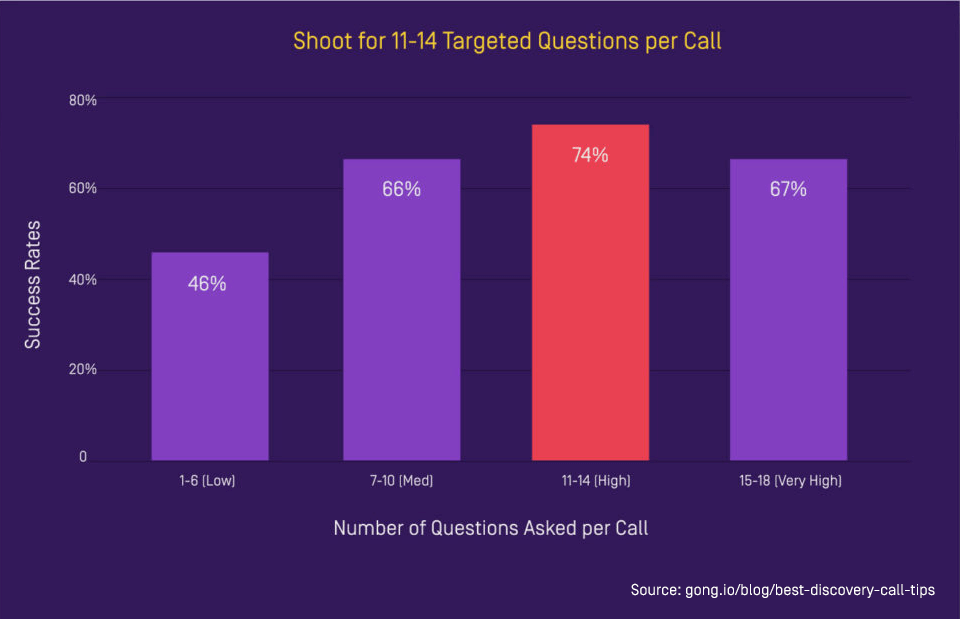
Heads up: this data does not hold water with the C-suite. In that case, fewer questions are better.
Finally, when do you ask those 11-14 questions? The non-top notch reps frontload the discovery call with a barrage of questions. The best reps spread out those questions — a conversation, not an interrogation.
Demo call sales script example #1: Tear apart the status quo
In a pretty, Gong’ified image:
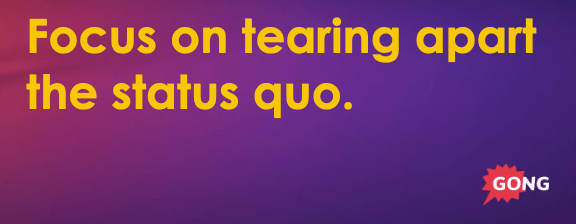
But what does that mean?
The status quo is “the existing state of affairs.” It’s “the way we’ve always done it, the way we currently do it.”
From a sales perspective, the status quo is what is causing your buyer pain and discomfort … the thing that is making their job more difficult or less efficient or more error-prone (or all 3).
The best sellers take that status quo and show the buyer why it’s no longer an option. If you can do that effectively, you are more likely to convince them your product answers all their problems.
And that puts you in the driver’s seat.
One of the best of all time at shattering the status quo? Steve Jobs, especially in his 2007 MacWorld keynote (iPhone reveal), where he famously said, “The most advanced phones are called smartphones (so they say).” Then shared how they were far from smart (or easy to use).
The visual helped drive the point home:
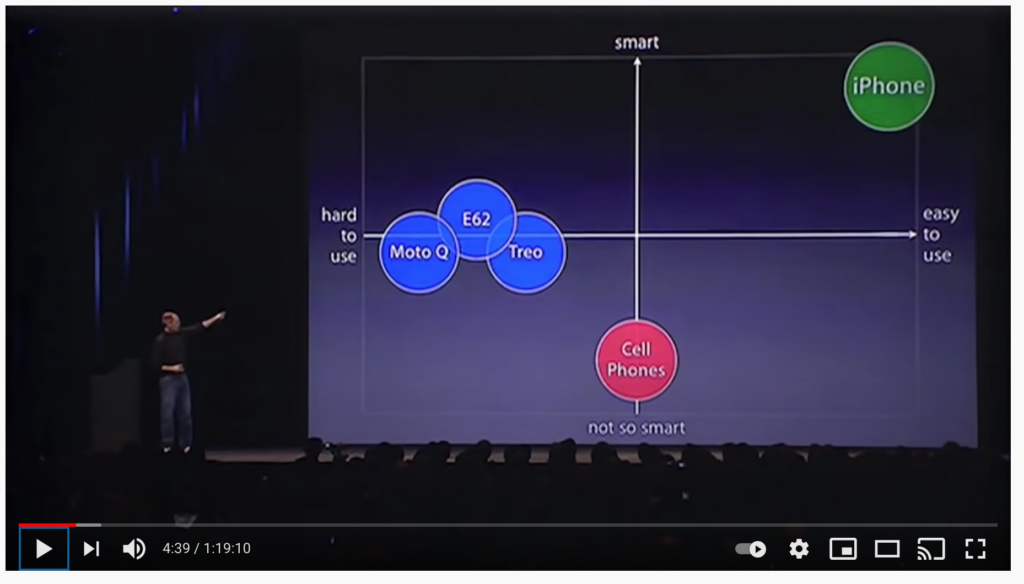
This tactic is super-effective during a sales product demo, especially one over video: Lean into the status quo and crush it — highlighting the dangers of the “doing what we’ve always done” mentality.
Status quo destruction is tied to loss aversion — the idea that people go to more extraordinary lengths to avoid losses than they do to gain benefits.
Here’s how it’s done, using a “loss pitch” instead of a “benefits pitch.”
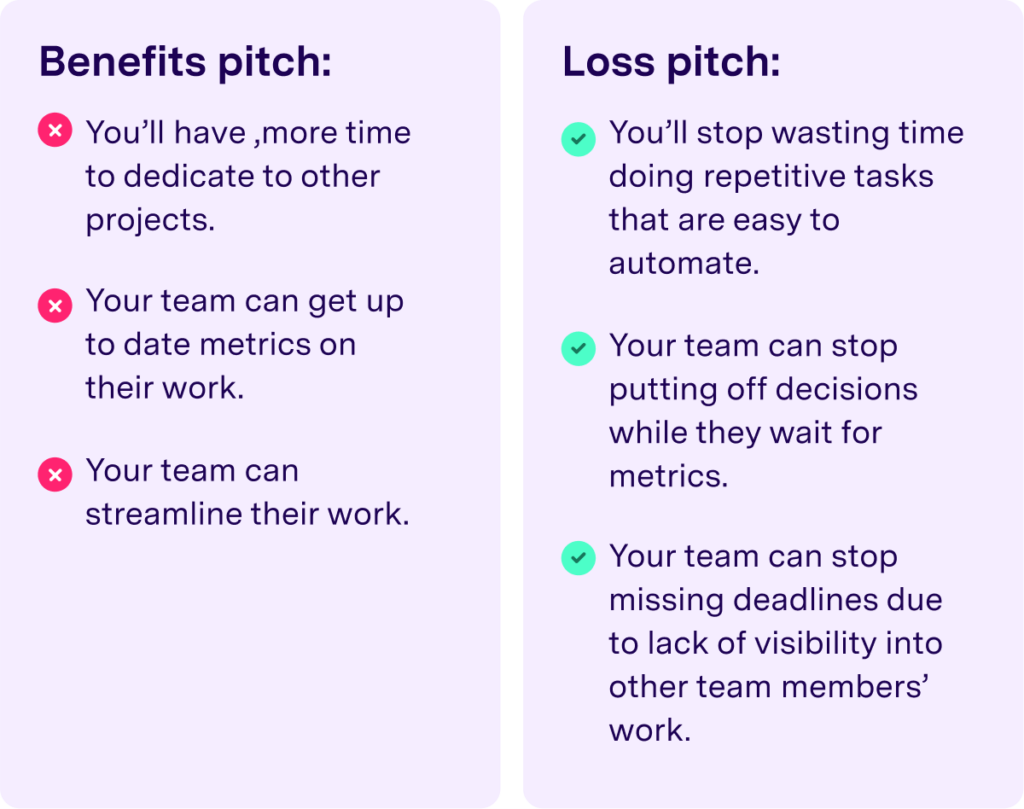
Demo call sales script example #2: Build off of your buyer’s current problem
Build off your buyer’s current problem. Re-validate everything you uncovered previously.
Get your buyer to say YES (and yes and yes and yes).
Don’t just assume (never a good thing) what your buyer told you in discovery is 100% accurate or still true. Priorities change. Needs shift, move around.
And the last thing you want is to be caught off-guard, heading down one path when a different one is the path.
Do not treat that precious discovery call as “one and done.”
Here’s how it’s done. Start every (yes, every) sales conversation with a question like this:
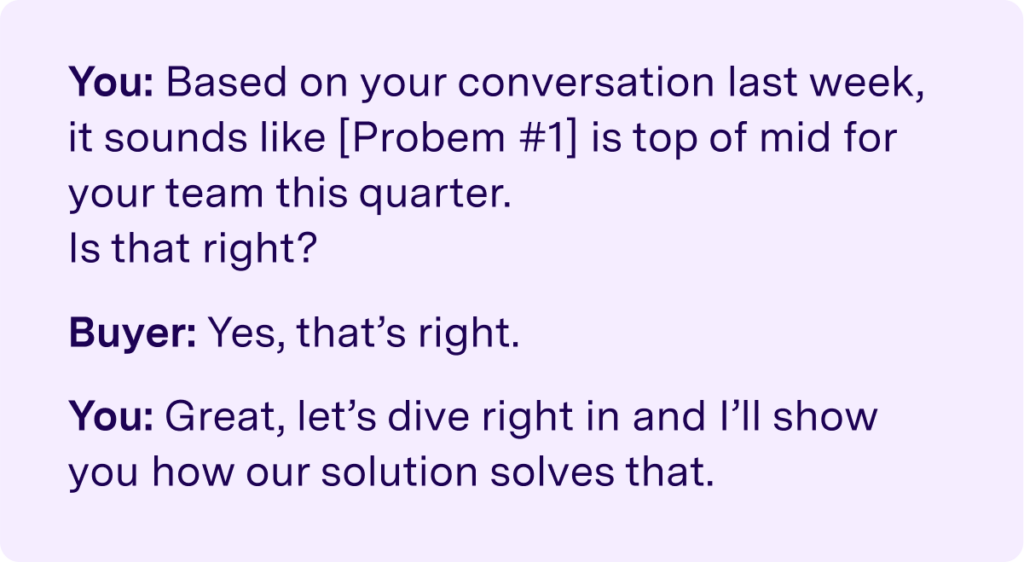
If they say anything other than yes (unless it’s HECK YEAH!), clarify the new path until you get to yes.
Demo call sales script example #3: Frame case studies as before/after stories
Salespeople are pretty darn good at telling “after” stories.
One of the best/easiest/most straightforward ways to do that: ROI.
Yet leading with ROI is not a winning formula.
The psychology: ROI triggers the logical (critical analysis) part of the brain. It gives them ammo to challenge your calculations: “That’s a big leap between what you say your product can do and the expected return. How did you calculate that again?”Again, not a winning formula.
Note: Using ROI works when you’ve already convinced your buyer to buy. At this point, ROI can help to rationalize their decision.
Instead, add the “before” part to the “after” customer story to neutralize the buyer’s logical brain … to put it to sleep for a bit.
Stories tap into the emotional brain. You can mention ROI as part of your story, but it should not be the main focus. A touch of ROI allows your buyer to rationalize their emotions.
People buy on emotion and justify with logic.
Without the “before,” the “after” has no context.
Here’s what an excellent before-after story looks like:
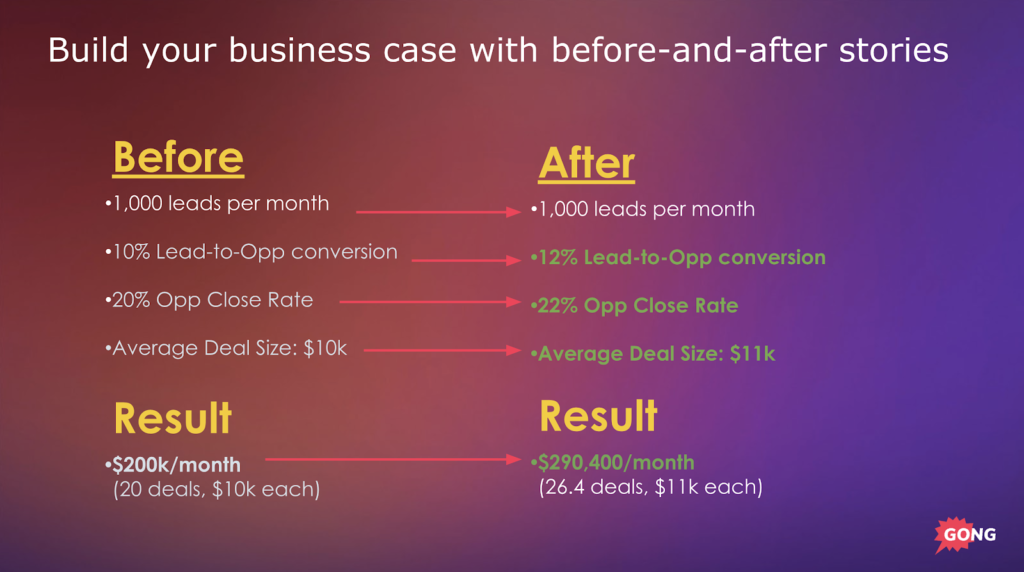
You’ve snuck in ROI, but now it’s in context, embedded with a logical, well-crafted, before/after story.
Here’s what it could sound like in sales script format:
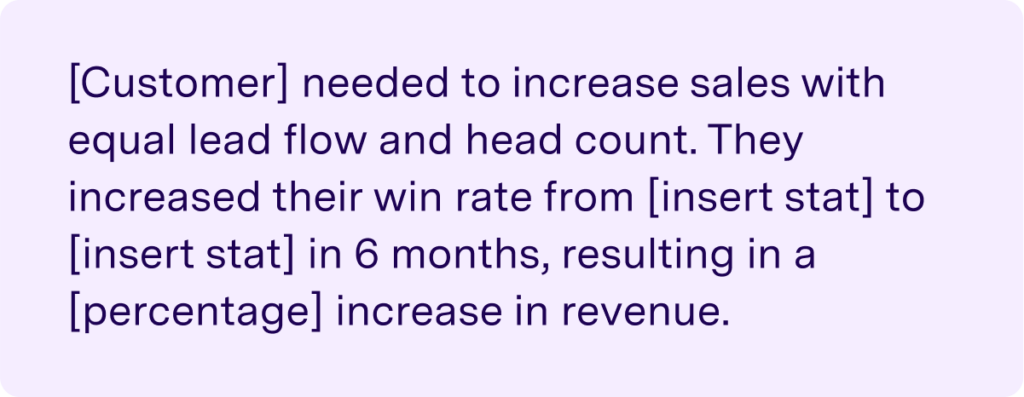
Grab these 3 money-making sales scripts examples (templates)
What we provided above is just a starting point to success, a tease, if you will.
The whole story lies in the actual call scripts we’ve built out for you. Grab them here, now.
These sales call scripts use psychological shortcuts to influence decision-making and are all (of course) backed by Gong data.
